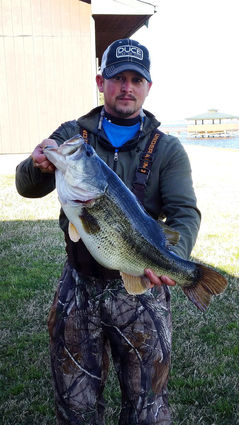Deep water can be the key
Last updated 3/7/2017 at Noon
Photo: Steven Juranka took this 9 pound 5 ounce largemouth from the south end of Toledo Bend on shallow flat near much deeper water.
For the Record
Capt. Chuck Uzzle
Show me an angler who shuns deep water and I’ll show you a fisherman
who’s missing plenty of fish. With so much attention being paid to shallow
water angling these days it’s no wonder your local fishing hole is growing
more crowded by the day, everybody wants to be in the “skinny water”
because that’s where the glamour happens. Well if you have fallen victim
to that line of thinking don't despair because you are not alone, it’s an
epidemic in the angling world that has one simple cure and that’s deep
water.
Defining deep water is up to each individual, to some folks deep is 3 feet
and to others it’s 30 feet. For all intents and purposes let’s define
deep as anything greater than 10 feet, this is where most folks get
uncomfortable fishing because it takes a different set of skills than that
of the guy in ankle deep water. Probing deep water takes time, good
electronics, an understanding of bottom structure and patience. If these
pre-requisites don’t sound to difficult or hard to handle and you want to
find fish that receive little or no pressure then read on because that’s
what you get when fish deep water.
Here on Sabine Lake we are both blessed and cursed with plenty of deep water
all around us, namely the Sabine and Neches rivers. For all the misery they
deal out with run off from up north they more than make up for it by
providing miles of under utilized, productive, and protected water. There is
absolutely nothing like knowing you always have a back up plan when you hit
the water, there is a security knowing you have a place to fish even in the
all but the absolute worst conditions. On Sabine lake we routinely take
advantage of the shelter provided by the Sabine river to catch a huge
variety of both fresh and saltwater fish including speckled trout, redfish,
striped bass, flounder, largemouth bass and so on. The secret to truly
taking advantage of the opportunity is understanding how to fish the deep
water.
In the Sabine River you have several different forms of structure to fish
with most popular being drop off’s and points. The drop off areas are key
spots to find hungry fish ambushing their next meal. Along the banks of the
river you have defined shelves that drop off from 4 to 8 feet of water and
then into the 12 to 20 foot depths and beyond. Baitfish will routinely
travel parallel to the bank in these shelves or troughs during tide
movements and the predator fish will not be far behind. One simple way to
locate a shelf or drop off is to look for the lines of crab trap buoys; they
are normally right on the drop off and make locating a productive area
mighty simple. Once you locate a stretch of bank where you intend the fish
the drop off look for a secondary piece of structure like a point or flat
along the bank. These areas are by far the most productive because the fish
have a shallow water area to chase bait with deep water access near by for
escape. The deep water also allows these fish a constant climate where they
will get comfortable and suspend.
Now that we have located our area to fish we need to decide what type of
bait we will use, live or artificial. For many Sabine anglers there are a
couple of proven choices both live and artificial. For the folks wanting to
throw natural baits the number one choice is live shad. Sometimes in the
colder parts of the year the shad can get scarce so mullet is the next best
thing. Another option that we have been using with great results is live
crawfish, especially when it comes to catching stripers. Now a standard
Carolina rig with a half ounce weight and a #4 kahle style hook on a 2-foot
leader works well in this situation. Under stronger or weaker tides you may
have to adjust the size of the weight accordingly, use just enough to hold
your bait in place but not so heavy that you can’t feel the soft strikes.
Now if live bait is not your game then you will need to look into some crank
baits or tube jigs. The most popular crank bait is the Hoginar, a small
blade style bait with a lead belly. The Hoginar is super simple to use
because you can work it in a variety of ways and still catch fish. The
standard “chunk and wind” method does well due to the huge amount of
vibration given off as the bait runs through the water. The vertical
“yo-yo” approach for suspended fish is also a big time producer. Other
crank baits like Rat-l-traps or the Manns Minus series crank baits will hold
their own as well under these circumstances.
Digging into deep water fishing can be an intimidating task for the beginner
but certainly is well worth the effort. The next time you cruise down your
favorite shallow shoreline and see the crowds lined up you will be glad to
know there is some uninhabited water out there with your name on it. Break
out the depth finder, have an open mind, and unlock the secrets to some
great fishing down in the deep.















Reader Comments(0)